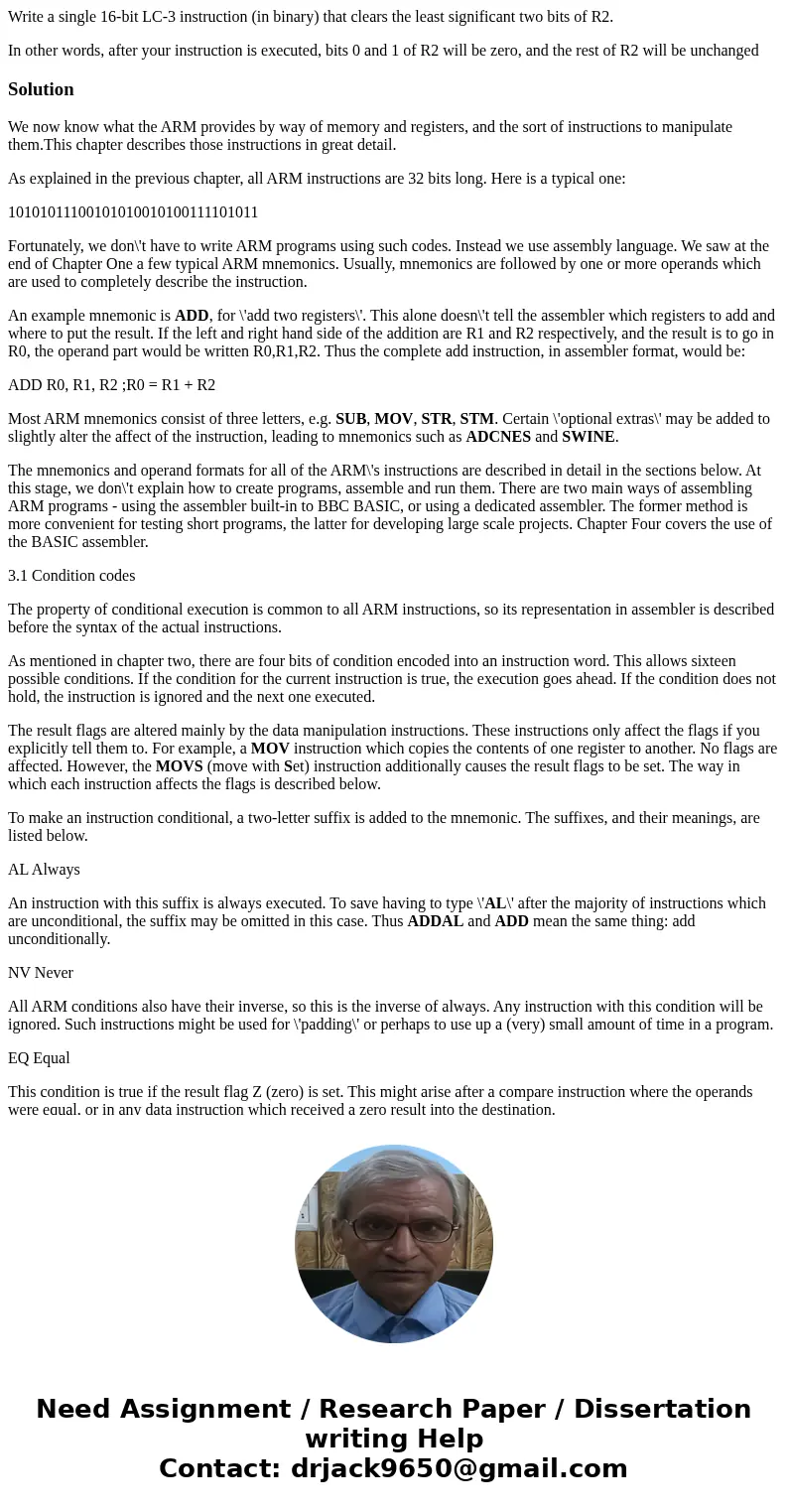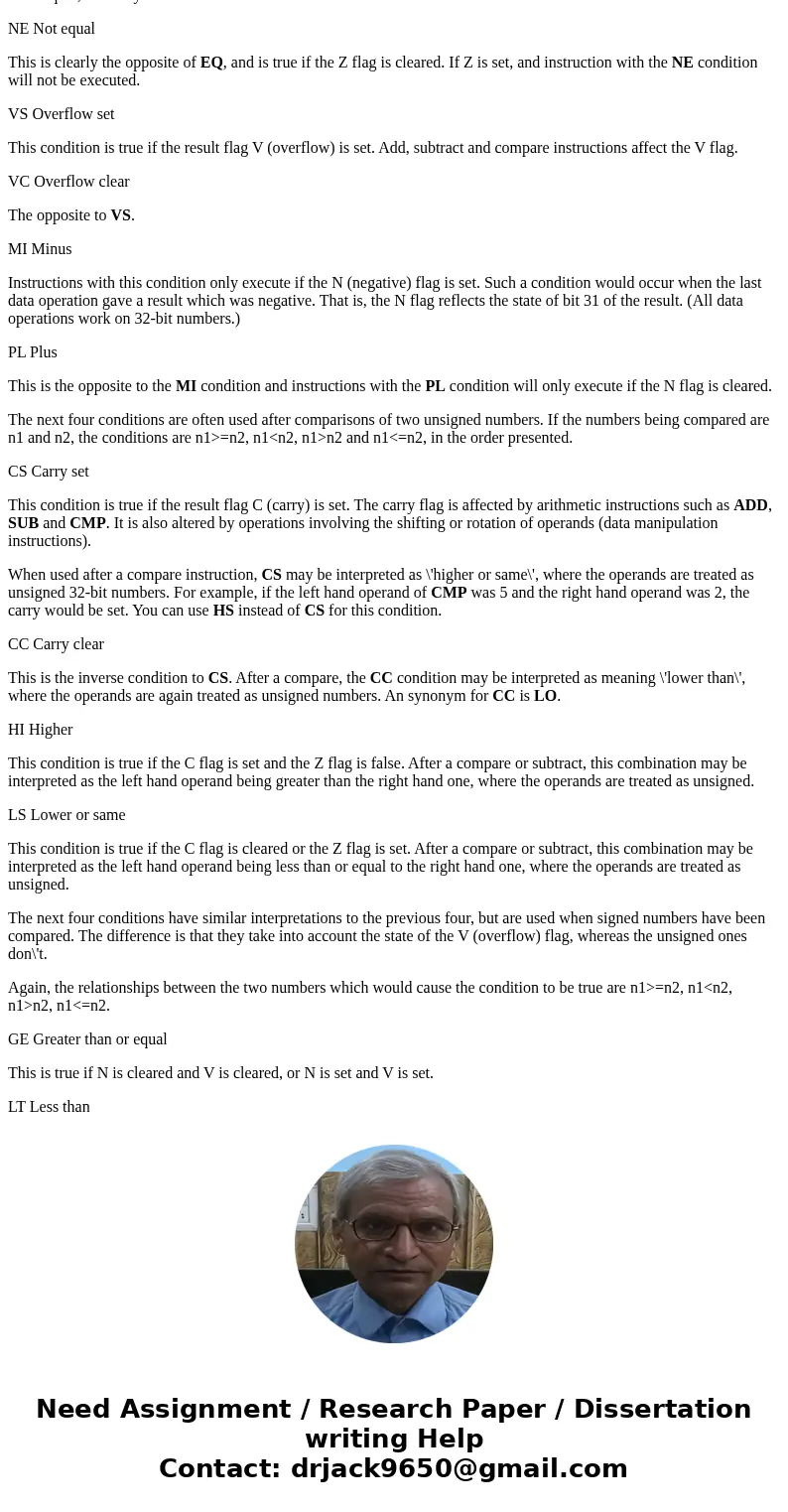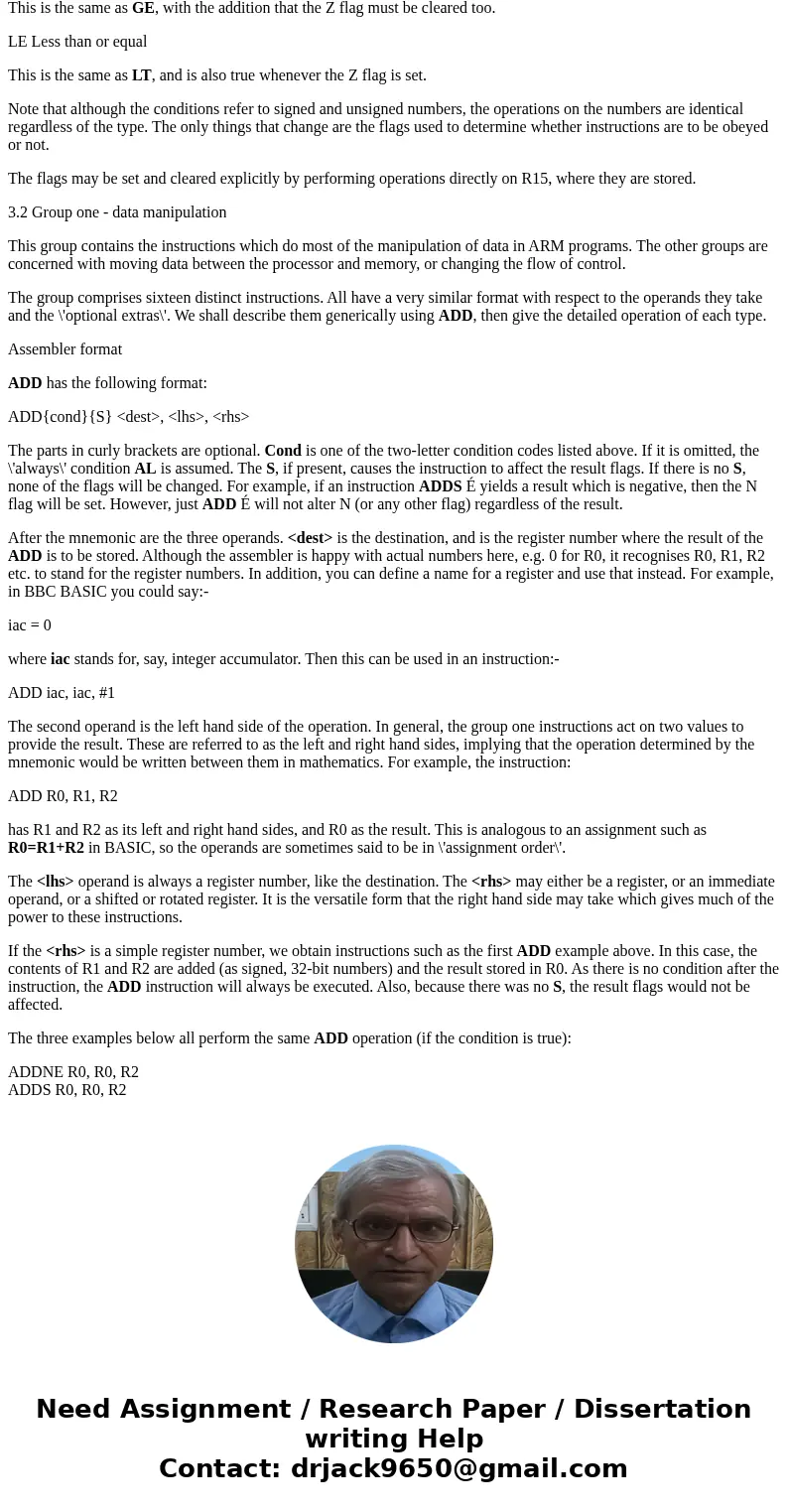Write a single 16bit LC3 instruction in binary that clears t
Write a single 16-bit LC-3 instruction (in binary) that clears the least significant two bits of R2.
In other words, after your instruction is executed, bits 0 and 1 of R2 will be zero, and the rest of R2 will be unchanged
Solution
We now know what the ARM provides by way of memory and registers, and the sort of instructions to manipulate them.This chapter describes those instructions in great detail.
As explained in the previous chapter, all ARM instructions are 32 bits long. Here is a typical one:
10101011100101010010100111101011
Fortunately, we don\'t have to write ARM programs using such codes. Instead we use assembly language. We saw at the end of Chapter One a few typical ARM mnemonics. Usually, mnemonics are followed by one or more operands which are used to completely describe the instruction.
An example mnemonic is ADD, for \'add two registers\'. This alone doesn\'t tell the assembler which registers to add and where to put the result. If the left and right hand side of the addition are R1 and R2 respectively, and the result is to go in R0, the operand part would be written R0,R1,R2. Thus the complete add instruction, in assembler format, would be:
ADD R0, R1, R2 ;R0 = R1 + R2
Most ARM mnemonics consist of three letters, e.g. SUB, MOV, STR, STM. Certain \'optional extras\' may be added to slightly alter the affect of the instruction, leading to mnemonics such as ADCNES and SWINE.
The mnemonics and operand formats for all of the ARM\'s instructions are described in detail in the sections below. At this stage, we don\'t explain how to create programs, assemble and run them. There are two main ways of assembling ARM programs - using the assembler built-in to BBC BASIC, or using a dedicated assembler. The former method is more convenient for testing short programs, the latter for developing large scale projects. Chapter Four covers the use of the BASIC assembler.
3.1 Condition codes
The property of conditional execution is common to all ARM instructions, so its representation in assembler is described before the syntax of the actual instructions.
As mentioned in chapter two, there are four bits of condition encoded into an instruction word. This allows sixteen possible conditions. If the condition for the current instruction is true, the execution goes ahead. If the condition does not hold, the instruction is ignored and the next one executed.
The result flags are altered mainly by the data manipulation instructions. These instructions only affect the flags if you explicitly tell them to. For example, a MOV instruction which copies the contents of one register to another. No flags are affected. However, the MOVS (move with Set) instruction additionally causes the result flags to be set. The way in which each instruction affects the flags is described below.
To make an instruction conditional, a two-letter suffix is added to the mnemonic. The suffixes, and their meanings, are listed below.
AL Always
An instruction with this suffix is always executed. To save having to type \'AL\' after the majority of instructions which are unconditional, the suffix may be omitted in this case. Thus ADDAL and ADD mean the same thing: add unconditionally.
NV Never
All ARM conditions also have their inverse, so this is the inverse of always. Any instruction with this condition will be ignored. Such instructions might be used for \'padding\' or perhaps to use up a (very) small amount of time in a program.
EQ Equal
This condition is true if the result flag Z (zero) is set. This might arise after a compare instruction where the operands were equal, or in any data instruction which received a zero result into the destination.
NE Not equal
This is clearly the opposite of EQ, and is true if the Z flag is cleared. If Z is set, and instruction with the NE condition will not be executed.
VS Overflow set
This condition is true if the result flag V (overflow) is set. Add, subtract and compare instructions affect the V flag.
VC Overflow clear
The opposite to VS.
MI Minus
Instructions with this condition only execute if the N (negative) flag is set. Such a condition would occur when the last data operation gave a result which was negative. That is, the N flag reflects the state of bit 31 of the result. (All data operations work on 32-bit numbers.)
PL Plus
This is the opposite to the MI condition and instructions with the PL condition will only execute if the N flag is cleared.
The next four conditions are often used after comparisons of two unsigned numbers. If the numbers being compared are n1 and n2, the conditions are n1>=n2, n1<n2, n1>n2 and n1<=n2, in the order presented.
CS Carry set
This condition is true if the result flag C (carry) is set. The carry flag is affected by arithmetic instructions such as ADD, SUB and CMP. It is also altered by operations involving the shifting or rotation of operands (data manipulation instructions).
When used after a compare instruction, CS may be interpreted as \'higher or same\', where the operands are treated as unsigned 32-bit numbers. For example, if the left hand operand of CMP was 5 and the right hand operand was 2, the carry would be set. You can use HS instead of CS for this condition.
CC Carry clear
This is the inverse condition to CS. After a compare, the CC condition may be interpreted as meaning \'lower than\', where the operands are again treated as unsigned numbers. An synonym for CC is LO.
HI Higher
This condition is true if the C flag is set and the Z flag is false. After a compare or subtract, this combination may be interpreted as the left hand operand being greater than the right hand one, where the operands are treated as unsigned.
LS Lower or same
This condition is true if the C flag is cleared or the Z flag is set. After a compare or subtract, this combination may be interpreted as the left hand operand being less than or equal to the right hand one, where the operands are treated as unsigned.
The next four conditions have similar interpretations to the previous four, but are used when signed numbers have been compared. The difference is that they take into account the state of the V (overflow) flag, whereas the unsigned ones don\'t.
Again, the relationships between the two numbers which would cause the condition to be true are n1>=n2, n1<n2, n1>n2, n1<=n2.
GE Greater than or equal
This is true if N is cleared and V is cleared, or N is set and V is set.
LT Less than
This is the opposite to GE and instructions with this condition are executed if N is set and V is cleared, or N is cleared and V is set.
GT Greater than
This is the same as GE, with the addition that the Z flag must be cleared too.
LE Less than or equal
This is the same as LT, and is also true whenever the Z flag is set.
Note that although the conditions refer to signed and unsigned numbers, the operations on the numbers are identical regardless of the type. The only things that change are the flags used to determine whether instructions are to be obeyed or not.
The flags may be set and cleared explicitly by performing operations directly on R15, where they are stored.
3.2 Group one - data manipulation
This group contains the instructions which do most of the manipulation of data in ARM programs. The other groups are concerned with moving data between the processor and memory, or changing the flow of control.
The group comprises sixteen distinct instructions. All have a very similar format with respect to the operands they take and the \'optional extras\'. We shall describe them generically using ADD, then give the detailed operation of each type.
Assembler format
ADD has the following format:
ADD{cond}{S} <dest>, <lhs>, <rhs>
The parts in curly brackets are optional. Cond is one of the two-letter condition codes listed above. If it is omitted, the \'always\' condition AL is assumed. The S, if present, causes the instruction to affect the result flags. If there is no S, none of the flags will be changed. For example, if an instruction ADDS É yields a result which is negative, then the N flag will be set. However, just ADD É will not alter N (or any other flag) regardless of the result.
After the mnemonic are the three operands. <dest> is the destination, and is the register number where the result of the ADD is to be stored. Although the assembler is happy with actual numbers here, e.g. 0 for R0, it recognises R0, R1, R2 etc. to stand for the register numbers. In addition, you can define a name for a register and use that instead. For example, in BBC BASIC you could say:-
iac = 0
where iac stands for, say, integer accumulator. Then this can be used in an instruction:-
ADD iac, iac, #1
The second operand is the left hand side of the operation. In general, the group one instructions act on two values to provide the result. These are referred to as the left and right hand sides, implying that the operation determined by the mnemonic would be written between them in mathematics. For example, the instruction:
ADD R0, R1, R2
has R1 and R2 as its left and right hand sides, and R0 as the result. This is analogous to an assignment such as R0=R1+R2 in BASIC, so the operands are sometimes said to be in \'assignment order\'.
The <lhs> operand is always a register number, like the destination. The <rhs> may either be a register, or an immediate operand, or a shifted or rotated register. It is the versatile form that the right hand side may take which gives much of the power to these instructions.
If the <rhs> is a simple register number, we obtain instructions such as the first ADD example above. In this case, the contents of R1 and R2 are added (as signed, 32-bit numbers) and the result stored in R0. As there is no condition after the instruction, the ADD instruction will always be executed. Also, because there was no S, the result flags would not be affected.
The three examples below all perform the same ADD operation (if the condition is true):
ADDNE R0, R0, R2
ADDS R0, R0, R2




 Homework Sourse
Homework Sourse